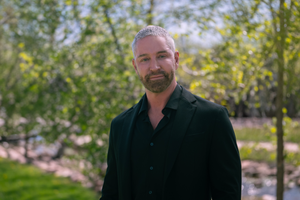
Don't let the laidback Australian-turned-Brit with a Midwestern twang accent fool you. Stephen Bye has one of the toughest jobs -- with the most riding on it -- in the entire North American wireless industry.
As the CTO of Sprint Corp. (NYSE: S), he has the whole world watching to see if he can complete the carrier's Network Vision. Even more daunting, he also has Masayoshi Son, the heavy-handed new owner and CEO of SoftBank Corp. , watching. And Son isn't one to keep his views on Sprint's upper management to himself. (See SoftBank's Son Keeps Sprint on Short Leash.)
Bye, who will be a keynote speaker at Light Reading's Big Telecom Event (BTE) in Chicago this June, also wears the hat of Sprint's vice president of technology development and corporate strategy. That means he's not only responsible for driving corporate and technology strategy, network architecture, and global standards. He's also responsible for running Sprint's innovation center and emerging technology lab in Kansas City and Silicon Valley, as well as being the lead for new business and service model development for the carrier.
Figure 1: Sprint CTO Stephen Bye 
Stephen Bye will be a keynote speaker at The Big Telecom Event (BTE), June 17/18 at the Sheraton Chicago Hotel and Towers.
What's more, following some management shuffling that will see Bob Azzi, senior vice president of networks, and Steve Elfman, president of network and technology, leave the company, Bye is even more on the front lines of Sprint's network building. He and newly appointed chief network officer John Saw are in charge of completing Sprint's Network Vision, including its LTE TDD overlay, and a planned 4G small cell deployment. And, of course, there's the possibility of having to manage a potential merger with T-Mobile US Inc. . (See John Saw to Become Sprint Network Boss.)
It's a tall order for a carrier that is also working to rip and replace its entire legacy network, integrate three disparate bands of spectrum to build a viable LTE network that erases its early bet on WiMax, and keep its customers from fleeing to the competition in the meantime. (See Sprint Feels the Churn Burn Before Spark, Sprint Slips Back in Customer Service, and Sprint Sparks Up Vendors for Faster 4G LTE.)
So is the Australian-born, London-educated network man up for the job? Sprint and SoftBank are certainly betting on it.
Bye's roots are actually in the cable industry, which bodes well for Son's vision of Sprint -- at least, the one he's pitching to the Federal Communications Commission (FCC) ). Bye spent five years as the vice president of wireless at Cox Communications Inc. , leaving the MSO in March 2011 to join Sprint as vice president of technology development. (See What's Next for Cox Wireless? and Cox Wireless: Soup to Nuts.)
Son spent time this month in Washington telling regulators how abysmal the US broadband situation is and promising Sprint's burgeoning LTE network as a cheap alternative to fixed broadband. Sprint Spark is promising speeds of 1 Gbit/s, and Son says that's enough to compete as a home broadband connection. Of course, some of this is posturing on Son's part as he tries to convince the FCC a merger with T-Mobile is necessary to launch a broadband price war in the US, where the telco-cable duopoly is getting rather cozy. But if that's his ultimate goal, Bye's history in cable makes him the best man for the job of taking on the big cable companies.
Importantly, he has the backing of his peers. "Stephen's broad industry background and deep technical knowledge has been a tremendous asset in moving Sprint forward," Kevin McGinnis, vice president of development and operations at Sprint's customer data-based business unit, Pinsight Media, told us. "His thought leadership, which is really what innovation is all about, has been instrumental in market-facing innovations like Sprint Spark and in internal programs to encourage our employees to be more empowered and entrepreneurial in their everyday jobs." (See Sprint Plays by Its Own Rules, Too.)
Network visions
Despite having all that on his plate, Bye found time to host an event recently in Chicago to fill in local reporters on how he sees the wireless world. He started by admitting that Sprint can never keep up with mobile data use. There are deadlines for Network Vision, but the operator will always be building more infrastructure to support the insatiable growth, he said. That challenge is even greater for Sprint than it is for its competitors, since it is the only US operator still promising unlimited data. (See Sprint Sparks to Reduce Churn, Save Unlimited and Sprint Eyes SDN to Re-Craft Its Core.)
"We look at all the demand in the market from every segment and the applications they consume, then build the best network," Bye said. "As more capacity is made available, the depth of the content gets richer."
The resulting network isn't homogenous. Bye's task right now is updating Network Vision markets with Sprint's layer cake Spark network of 800 MHz spectrum for in-building penetration, 1,900 MHz midband spectrum to reach rural areas, and 2.5 GHz spectrum, which Bye called Sprint's workhorse for capacity and speeds. He said the carrier works on three cell sites a day. This year, it will begin augmenting those macro sites with small cells, both indoors and outdoors. (See Sprint Plans Indoor, Outdoor Small Cells in 2014.)
Next page: Sprint's role in the app world
Sprint's role in the app world
Like its competitors, Sprint is courting app developers to bring the latest and greatest innovations to its networks. Unlike those with hidden agendas, Sprint says, it's taking a completely open approach to the market. Evidence of such is the Sprint Accelerator in Kansas City, which focuses on bringing innovation to the healthcare industry. The Accelerator, which just opened its first class of 10 startups, was a result of a missive from Bye's office. (See Sprint Accelerator: Changing Carrier DNA and Sprint Welcomes 10 Health Startups to Its Accelerator.)
That's because he sees the Sprint network as an enabler. "We are building this network and providing it to so many people, we are opening another dimension of connectivity." In return, it opens up "tremendous business opportunity for innovation and development."
Bye spoke of the early days of wireless, when operators custom designed and built their own devices and owned the content and apps on them. Now the operators manage a platform -- a dumb pipe, as some might call it -- that enables others to innovate on top of the network. "Facebook, Google, Instagram -- all have created value for us, making our connectivity more valuable. We're still at the beginning of the next wave of innovation."
Bye has met with startups across the country and even outside the US, and he marvels at how low the barrier to entry is in mobile apps. Sprint doesn't pick the winners or losers. However, if he had to pick a winner, it would likely come from the world of gaming. That, of course, is a nod to SoftBank, which is a big investor in mobile gaming companies such as Supercell. (See SoftBank's Supercell Buy Tops Mobile M&A.)
Though Bye says the market will pick the winner in mobile apps, he does want to see a shakeup in the operating system sector. All the operators want viable alternative to Android and iOS.
"Any market of two is not a competitive market. You see that across the board, even in wireless," he said -- a not-so-subtle reference to the US market dominance of AT&T Inc. (NYSE: T) and Verizon Wireless . "iOS and Android is great, but it's a market of two. A duopoly."
This year, Sprint is determined to take down the AT&T/Verizon duopoly, but the network operator does not think it can necessarily do that alone. That's why Son is pushing for a merger with T-Mobile. Whether it's agreed on by the companies or approved by the regulators remains to be seen. Either way, one thing is clear -- Bye has a massive task in front of him, and he's one North American influencer to watch closely as the drama continues to unfold.
— Sarah Reedy, Senior Editor, Light Reading
Want to learn more about this topic? Check out the agenda for the Big Telecom Event (BTE), which will take place June 17-18 at the Sheraton Chicago Hotel and Towers. The event combines the educational power of interactive conference sessions devised and hosted by Heavy Reading's experienced industry analysts with multi-vendor interoperability and proof-of-concept networking and application showcases. For more on the event, the topics, and the stellar service provider speaker lineup, see Telecommunication Luminaries to Discuss the Hottest Industry Trends at Light Reading's Big Telecom Event in June.
About the Author(s)
You May Also Like












